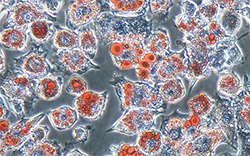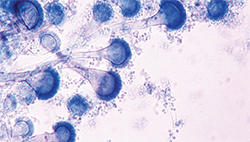From the journals: May 2018
We offer a selection of recent papers on a variety of topics from the Journal of Biological Chemistry, the Journal of Lipid Research and Molecular & Cellular Proteomics.
Healthy octogenarians with high CEC
 A study of healthy Brazilian octogenarians, such as this man in Paraty, Brazil, showed that they have higher cholesterol efflux capacity than their middle-aged counterparts.Courtesy of Adam Jones/Wikimedia Many scoring methods designed to help doctors predict whether a patient is at risk for cardiovascular disease are not accurate in elderly adults. As life expectancy grows longer around the world, the search is on for new ways to measure risk beyond the traditional cholesterol test and life history. In a recent study in the Journal of Lipid Research, Francesca Zimetti and colleagues at the University of Parma in Italy and the State University of Campinas, Brazil, set out to determine if cholesterol efflux capacity, or CEC, should be considered a risk factor in healthy adults aged 80 or older. CEC is shorthand for the ability of arterial macrophages to release excess cholesterol, preventing it from accumulating on artery walls. In younger adults, high CEC correlates with a reduction in early signs of atherosclerosis. While this association did not hold in a group of Brazilian adults who had reached their 80s in good health, the octogenarians had significantly higher cholesterol efflux capacity than their middle-aged counterparts. The authors caution that the healthy elderly patients should be compared to patients over 80 with cardiovascular disease to be certain, but suggest that high CEC may promote longevity.
A study of healthy Brazilian octogenarians, such as this man in Paraty, Brazil, showed that they have higher cholesterol efflux capacity than their middle-aged counterparts.Courtesy of Adam Jones/Wikimedia Many scoring methods designed to help doctors predict whether a patient is at risk for cardiovascular disease are not accurate in elderly adults. As life expectancy grows longer around the world, the search is on for new ways to measure risk beyond the traditional cholesterol test and life history. In a recent study in the Journal of Lipid Research, Francesca Zimetti and colleagues at the University of Parma in Italy and the State University of Campinas, Brazil, set out to determine if cholesterol efflux capacity, or CEC, should be considered a risk factor in healthy adults aged 80 or older. CEC is shorthand for the ability of arterial macrophages to release excess cholesterol, preventing it from accumulating on artery walls. In younger adults, high CEC correlates with a reduction in early signs of atherosclerosis. While this association did not hold in a group of Brazilian adults who had reached their 80s in good health, the octogenarians had significantly higher cholesterol efflux capacity than their middle-aged counterparts. The authors caution that the healthy elderly patients should be compared to patients over 80 with cardiovascular disease to be certain, but suggest that high CEC may promote longevity.
Molecular secrets of bacterial signaling
Cyclic di-adenosine monophosphate is an essential bacterial signaling molecule, the functions of which are still incompletely understood. Angelika Gründling and colleagues at Imperial College London examined the role of c-di-AMP in the pathogen Staphylococcus aureus, which is unable to grow without c-di-AMP in rich medium but able to in minimal medium. Their experiments suggested that c-di-AMP is required for regulating osmolyte intake. Furthermore, they showed that methicillin-resistant S. aureus strains lacking c-di-AMP were hypersensitive to a beta-lactam antibiotic, suggesting that targeting c-di-AMP may be a strategy for treating drug-resistant staph infections. The findings were published in the Journal of Biological Chemistry.
Fatty acid addition lets a parasite stick
Trichomonas vaginalis, commonly known as trich, is the most common curable sexually transmitted disease, and the vast majority of people with the disease — upward of 70 percent — do not experience symptoms, according to the Centers for Disease Control and Prevention. However, the protozoan parasite can increase an infected person’s risk of contracting HIV or developing cancer and can cause preterm labor in pregnant women. In other parasites, a protein modification called palmitoylation, the addition of a 16-carbon saturated fatty acid to cysteine residues of a protein, regulates infectivity. In a new paper in the journal Molecular & Cellular Proteomics, researchers at the Instituto Tecnologico de Chascomus in Buenos Aires and the University of California, Los Angeles, enriched palmitoylated proteins from T. vaginalis and found numerous palmitoylation sites in pathogenesis-related proteins. Yesica Nievas and colleagues report that disrupting palmitoylation reduced the protist’s self-aggregation and adhesion to host cells. This work establishes the importance of palmitoylation in T. vaginalis proteins for infection and suggests that palmitoylation enzyme inhibitors may help treat the infection.
MicroRNAs promote fat cell apoptosis
 A micrograph of fat cells stained with Oil Red O shows their lipid vesicle contents.Courtesy of M. Oktar Goluglu/Wikimedia Weight loss can be hard to sustain. The total mass of adipose tissue depends both on the number of fat cells, or adipocytes, and their average size. During weight loss, the amount of fat stored in each cell drops, but the total number of cells stays the same, making it easy to regain weight when a caloric surplus is available. Therefore, being able to selectively kill adipocytes or their precursor cells, preadipocytes, may be a way to make weight loss last. In a paper in the Journal of Lipid Research, Zhenzhen Zhang and colleagues at Northwest A&F University in Shaanxi, China, reported that in a model for apoptosis in fat cells, two microRNAs are important drivers of the programmed cell death pathway. These microRNAs, miR-103 and 107, suppress the production of a protein called wnt3a that reduces apoptosis. Overall, the microRNAs led to more programmed cell death. Targeting these microRNAs could someday become a route to killing adipocytes.
A micrograph of fat cells stained with Oil Red O shows their lipid vesicle contents.Courtesy of M. Oktar Goluglu/Wikimedia Weight loss can be hard to sustain. The total mass of adipose tissue depends both on the number of fat cells, or adipocytes, and their average size. During weight loss, the amount of fat stored in each cell drops, but the total number of cells stays the same, making it easy to regain weight when a caloric surplus is available. Therefore, being able to selectively kill adipocytes or their precursor cells, preadipocytes, may be a way to make weight loss last. In a paper in the Journal of Lipid Research, Zhenzhen Zhang and colleagues at Northwest A&F University in Shaanxi, China, reported that in a model for apoptosis in fat cells, two microRNAs are important drivers of the programmed cell death pathway. These microRNAs, miR-103 and 107, suppress the production of a protein called wnt3a that reduces apoptosis. Overall, the microRNAs led to more programmed cell death. Targeting these microRNAs could someday become a route to killing adipocytes.
Fat can cause selective insulin resistance
Ordinarily, insulin causes cells in the liver to switch energy sources by turning down the activity of enzymes that make new glucose and increasing the activity of genes that govern lipid synthesis. This switch lets cells store energy when blood glucose is abundant. But in diabetes, a paradox occurs: Insulin fails to shut off gluconeogenesis while still stimulating lipid synthesis. To find out how this phenomenon, called selective insulin resistance, can arise, researchers at Harvard University and the Broad Institute reduced the complexity of the problem by studying the effects of the fatty acid palmitate on insulin signaling in cultured liver cells. The researchers, Zhihuan Li and colleagues, reported in the journal Molecular & Cellular Proteomics that the presence of palmitate increased glycerolipid levels and disrupted a small number of proteins that normally would respond to insulin, including the transcription factors FoxO1 and NFkappaB and the kinase GSK3. The researchers also identified many previously unknown insulin-induced phosphorylation sites. They propose that their comprehensive data set may be useful for generating hypotheses about how insulin signaling is controlled in the more complex environment of the liver.
Primate tau problems
Defects in the protein tau, which is abundant in the central nervous system, are associated with both Alzheimer’s and Parkinson’s disease. The tau protein of primates has an N-terminal motif that is absent in tau from other mammals. Arne Ittner and colleagues at the University of New South Wales investigated whether this region may be responsible for humans’ increased susceptibility to tau-related disorders compared with other animals. They found that this region mediates interactions with several neuronal proteins. Because protein interactions affect tau pathology, this motif may be critical for understanding neurodegenerative diseases. The research was published in the Journal of Biological Chemistry.
How a fungus outfoxes the macrophage
 An illustration of Aspergillus fumigatus.Courtesy of LIFE Worldwide/NIH flickr Aspergillus fumigatus is an opportunistic pathogen in the lung. People with compromised immune systems, either from disease or immune-suppression therapy, are especially vulnerable to the airborne mold spores called conidia. In a healthy person, macrophages in the alveoli take up the fungus, and normally an acidic organelle called the phagolysosome destroys it. Conidia from A. fumigatus, however, disrupt acidification of the phagolysosome and prevent the infected macrophage from committing suicide through apoptosis. Researchers at the Leibniz Institute for Natural Product Research and Infection Biology in Germany investigated the immune evasion strategies the pathogen uses by infecting cultured macrophages with magnetically tagged Aspergillus conidia from a virulent strain or a less infectious mutant strain. Hella Schmidt and colleagues then extracted phagolysosomes from macrophages infected with each strain and compared their proteomes. In a paper in the journal Molecular & Cellular Proteomics, the team reporteds that the more virulent strain reduces maturation of the phagolysosome and proinflammatory immune signaling. These disruptions ensured that the more virulent strain had a comfortable place to survive inside the host.
An illustration of Aspergillus fumigatus.Courtesy of LIFE Worldwide/NIH flickr Aspergillus fumigatus is an opportunistic pathogen in the lung. People with compromised immune systems, either from disease or immune-suppression therapy, are especially vulnerable to the airborne mold spores called conidia. In a healthy person, macrophages in the alveoli take up the fungus, and normally an acidic organelle called the phagolysosome destroys it. Conidia from A. fumigatus, however, disrupt acidification of the phagolysosome and prevent the infected macrophage from committing suicide through apoptosis. Researchers at the Leibniz Institute for Natural Product Research and Infection Biology in Germany investigated the immune evasion strategies the pathogen uses by infecting cultured macrophages with magnetically tagged Aspergillus conidia from a virulent strain or a less infectious mutant strain. Hella Schmidt and colleagues then extracted phagolysosomes from macrophages infected with each strain and compared their proteomes. In a paper in the journal Molecular & Cellular Proteomics, the team reporteds that the more virulent strain reduces maturation of the phagolysosome and proinflammatory immune signaling. These disruptions ensured that the more virulent strain had a comfortable place to survive inside the host.
A potential oncogene for gastric cancer
Gastric cancer has one of the highest mortality rates among cancers, but its mechanisms and biomarkers remain poorly understood. Zhengsheng Wu and colleagues at Anhui Medical University in China showed that the proline-rich protein GSE1, which previously was known to have an oncogenic role in breast cancer, promotes gastric cancer proliferation, invasion and metastasis both in vitro and in mouse models. Its expression correlated with patterns of survival and relapse in gastric cancer patients. GSE1’s cancer-promoting role appeared to involve the amino acid transporter SLC7A5, which was upregulated when GSE1 stabilized the SLC7A5 transcript. The research was published in the Journal of Biological Chemistry.
Eicosanoid profile in cultured cells
Cultured cells depend on media for many essential nutrients, among them polyunsaturated fatty acids. Researchers observed that cells’ production of signaling lipids derived from PUFAs by cultured macrophages changes over time between media changes as the cells exhaust the available essential PUFAs. In an article in the Journal of Lipid Research, Toshiaki Okuno and colleagues from Jutendo University in Japan and the University of Colorado in Denver quantified the changes to various lipids. In addition to fluctuating lipid levels, they observed that the number of days since the previous media change dramatically altered tumor necrosis factor secretion in response to lipopolysaccharide, an inflammation mediator. The study suggests that cell feeding schedules may introduce variability among in vitro experiments, which could be reduced by flow-through culture.
Phases of aggregation in Huntington’s disease
In Huntington’s disease patients, the huntingtin protein has extended lengths of repeated glutamines at one end, which cause the protein to form neurotoxic aggregates. In a paper in the Journal of Biological Chemistry, Rohit Pappu and colleagues at Washington University in St. Louis found that these aggregates fall into three distinct categories delineated by concentration thresholds, sizes and morphologies. They also found that profilin, an actin-binding protein known to reduce huntingtin aggregation, interacts with aggregates in one specific phase. Understanding the phase behavior of huntingtin and other aggregation-prone proteins may be important for developing therapies.
How calcium pump rates relate to skin health
Darier disease is a rare autosomal dominant disorder of the skin characterized by severe rashes or lesions caused by mutations in a particular isoform of the sarcoendoplasmic reticulum calcium transport ATPase, or SERCA. Jens Peter Andersen and colleagues at Aarhus University in Denmark reported in the Journal of Biological Chemistry that a Darier disease mutation affected the interaction between an isoform-specific cytoplasmic loop and other regions of the protein. This change increased SERCA’s calcium transport rate, which could activate a stress response and induce apoptosis, perhaps explaining its role in Darier disease pathology.
Enjoy reading ASBMB Today?
Become a member to receive the print edition four times a year and the digital edition monthly.
Learn moreGet the latest from ASBMB Today
Enter your email address, and we’ll send you a weekly email with recent articles, interviews and more.
Latest in Science
Science highlights or most popular articles

Using DNA barcodes to capture local biodiversity
Undergraduate at the University of California, Santa Barbara, leads citizen science initiative to engage the public in DNA barcoding to catalog local biodiversity, fostering community involvement in science.

Targeting Toxoplasma parasites and their protein accomplices
Researchers identify that a Toxoplasma gondii enzyme drives parasite's survival. Read more about this recent study from the Journal of Lipid Research.

Scavenger protein receptor aids the transport of lipoproteins
Scientists elucidated how two major splice variants of scavenger receptors affect cellular localization in endothelial cells. Read more about this recent study from the Journal of Lipid Research.

Fat cells are a culprit in osteoporosis
Scientists reveal that lipid transfer from bone marrow adipocytes to osteoblasts impairs bone formation by downregulating osteogenic proteins and inducing ferroptosis. Read more about this recent study from the Journal of Lipid Research.

Unraveling oncogenesis: What makes cancer tick?
Learn about the ASBMB 2025 symposium on oncogenic hubs: chromatin regulatory and transcriptional complexes in cancer.

Exploring lipid metabolism: A journey through time and innovation
Recent lipid metabolism research has unveiled critical insights into lipid–protein interactions, offering potential therapeutic targets for metabolic and neurodegenerative diseases. Check out the latest in lipid science at the ASBMB annual meeting.

.jpg?lang=en-US&width=300&height=300&ext=.jpg)
